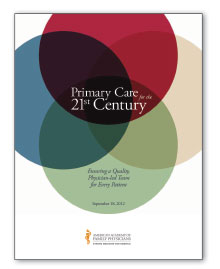Nurse practitioners are no substitute for physician-led team
By Roland Goertz, M.D., M.B.A.; Chair, AAFP Board of Directors
By the year 2020, our nation is expected to face a shortage of 45,000 primary care physicians. To address this shortfall, as well as rising health care costs, the nation is seeing a movement to grant independent practice to nurse practitioners.
But, this flawed, stop-gap approach overlooks some obvious obstacles to replacing physicians with non-physicians. For example:
- The nursing field faces its own deficit with a shortage of 260,000 nurses projected for 2025. You can’t fill a gap with something else you lack.
- Though some have supported the idea of independent nurse practitioners because of the lower costs involved with training and employing nurses, the approach fails to consider that those savings may be offset by decreased productivity and less efficient use of staff resources.
- Granting independent practice to nurse practitioners would create two classes of care: one run by a physician-led team and one run by less-qualified health care professionals. Physicians are required to complete roughly 16,000 more hours of training than nurse practitioners.
The Academy addressed all these issues when it released a report—with support from the American Academy of Pediatrics, the AMA, and the American Osteopathic Association—that explains in detail the differences in training and clinical expertise between physicians and nurses, why a team-based approach is preferable, and why substituting non-physicians for physicians just won’t work.
Our report is intended, in part, to educate the public about those differences in training. Consumers are not discerning purchasers of health care when they don’t know the facts. Many patients, however, already express a preference for physicians. According to a recent AMA patient survey, 86 percent of respondents said that they benefit when a physician leads a primary care team, and 75 percent said they prefer to be treated by a physician—even if it takes longer to get an appointment.
At a time when AAFP is advocating a team-based approach to health care to improve outcomes and lower costs, some nurse practitioners are eager to go it alone. Our report makes a strong statement that the patient-centered medical home model is designed to be run with a physician leading a team of health care professionals. A recent report by the Patient-Centered Primary Care Collaborative offers more than 30 examples of public and private payers finding that better care, better outcomes, and lower costs are possible in the PCMH model. Specifically, team-based care has been proven to reduce emergency room visits, hospital admissions, and total inpatient stays.
The PCMH gives patients access to physicians, nurse practitioners, physician assistants, and other health care professionals. Together, these health care professionals can complement each other with their experience and expertise.
Finally, the report stresses that national workforce policies are needed to ensure adequate supplies of family physicians and other health care professionals to improve access to quality care and avert the anticipated shortages of primary care physicians and nurses. Wholesale substitution of non-physicians for physicians is not, and should not be, an option.
This post was originally published on the AAFP Leader Voices blog. Republished with permission.
